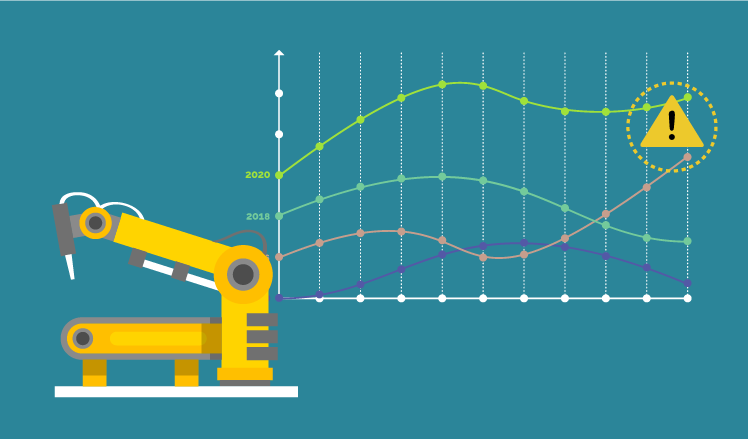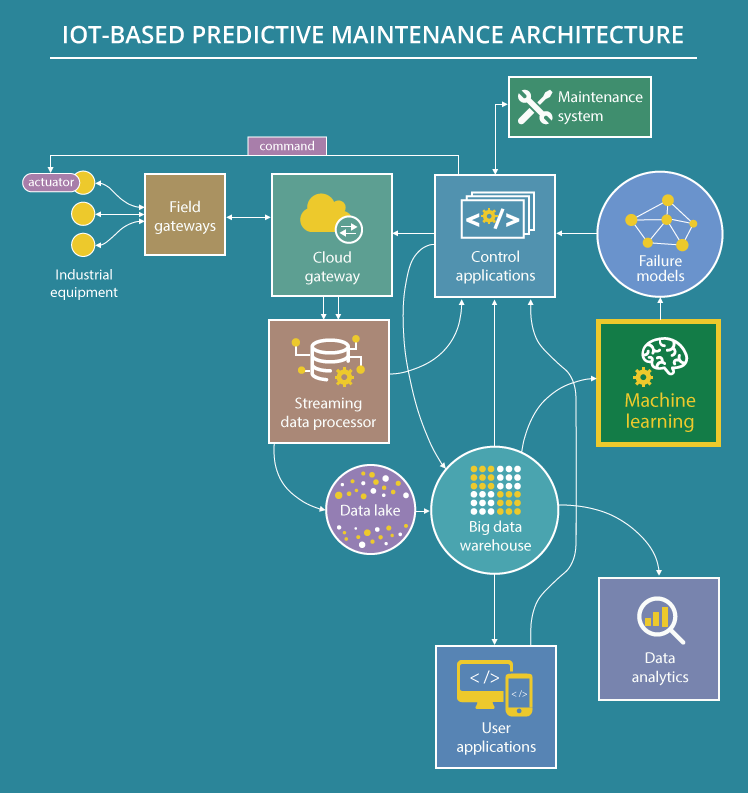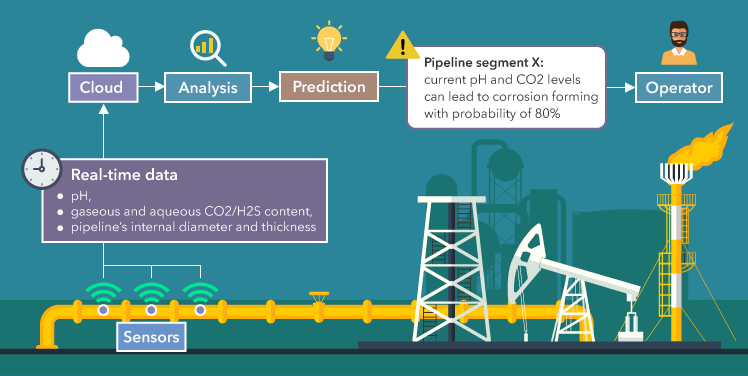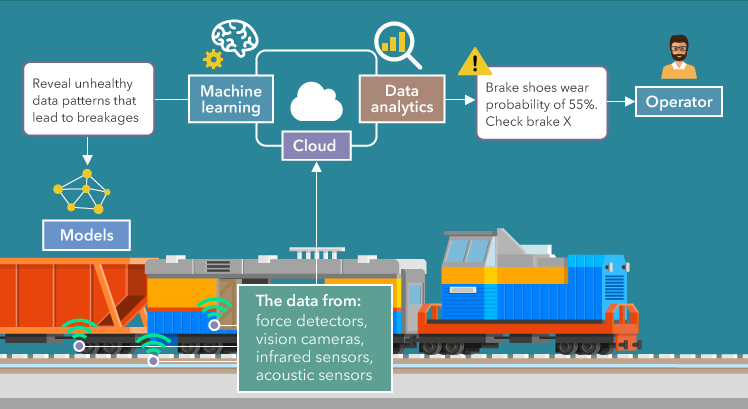A comprehensive guide to IoT-based predictive maintenance
For years, manufacturers have been practicing a time-based approach to the equipment maintenance. They used to take the age of machinery as the factor for planning the maintenance routine. The older the equipment the more frequent maintenance procedures need to be carried out. The ARC group study states, however, that worldwide, only 18% of equipment has failed due to its age, while 82% of failures occur randomly. It proves that a time-based approach is not cost-effective – a piece of equipment gets maintained irrespective of the actual need.
To avoid ineffective maintenance routine and costs that accompany it, manufacturers can leverage Industrial IoT and data science. In this article, we’ll explain how predictive maintenance based on IoT helps to optimize the manufacturing process.

Why IoT?
You may be wondering: why should I roll out an IIoT solution if there is good old SCADA to uphold the maintenance activities? Let’s see.
Predictive maintenance requires the ability to process large amounts of data and run sophisticated algorithms, which cannot be achieved with local implementation within SCADA. An IoT-based solution like a smart factory app, on the other hand, allows storing terabytes of data and running machine learning algorithms on several computers in parallel to forecast potential hazards and pinpoint when industrial equipment is likely to fail.
For a robust IoT-based predictive maintenance solution, a thought-through architecture is a must.
Let’s see which components make predictive maintenance work and how they cooperate with one another illustrated by the example of an IIoT solution that predicts the end of life of industrial batteries.
An IoT-based predictive maintenance architecture
Before going into technical details, it is important to identify key variables which determine the health of a battery. They are temperature, voltage and discharge. Once the variables are identified, batteries get equipped with sensors to gather the data about these parameters and relay it to the cloud for processing.
Sensor data cannot pass directly to the cloud – it goes through gateways. Field gateways are physical devices that filter and preprocess the data. A cloud gateway ensures safe data transmission and provides connectivity via various protocols, which allows connecting various field gateways.
Once sensor data enters the cloud part it “lands” on a streaming data processor. Its purpose is to allow continuous flow of data and quickly and efficiently transmit data streams to a data storage – a data lake.
A data lake stores the data gathered by sensors. It is still raw, so it may be inaccurate, erroneous or contain irrelevant items. It is presented as a number of sets of sensor readings measured at the corresponding time. When the data is needed for insights about battery’s health, it is loaded to a big data warehouse.
The big data warehouse stores cleansed structured data. It contains temperature, voltage and discharge parameters measured at a particular time and contextual information about batteries’ types, locations, recharge dates, etc.
Once the data is prepared, it is analyzed with machine learning (ML) algorithms. ML algorithms are applied to reveal hidden correlations in data sets and detect abnormal data patterns. The recognized data patterns are reflected in predictive models.
Predictive models are built, trained and then used to identify whether self-discharge occurs in a battery, pinpoint the batteries with capacity lower than normal or estimate batteries’ remaining useful life. The predictive models used for predictively maintaining industrial batteries are built based on two approaches:
- Classification approach - models built according to this approach identify whether a battery is likely to self-discharge and show if the capacity of a battery is lower than normal or not.
- Regression approach - models provide the information on how many days/cycles are left until a battery’s useful life ends.
Predictive models are regularly updated, say, once a month, and tested for accuracy. If the output differs from the expected one, they are revised, retrained and tested again, until they function as intended.
Before getting down to machine learning, a good amount of exploratory analytics should be carried out. Data analysis is carried out to find dependencies and discover patterns and insights in the machine learning data sets. Moreover, during the exploratory analytics stage, various technical assumptions are assessed to help select the best-fit machine learning algorithm.
User applications allow an IoT-based predictive maintenance solution to alert users of a potential battery failure.

Although not relevant for the battery case, a predictive maintenance architecture can include additional components, such as actuators and control applications. Based on the results of the prediction, control applications may be set to send commands to the equipment’s actuators. For instance, if an engine’s temperature is rising to a critical point, control applications may send a command to set a machine in a cool-down mode. Additionally, control applications can be integrated with maintenance systems.
Predictive maintenance by industries
These universal architecture components are used to “build” predictive maintenance solutions for various industries. Below, we list possible predictive maintenance applications and provide examples of manufacturers who have already implemented IoT-based predictive maintenance solutions.
Discrete manufacturing
Major discrete manufacturers are using predictive maintenance based on IoT to monitor, for example, the health of spindles in milling machines. They are prone to breaking, while their repair is expensive. An IoT-based predictive maintenance solution can help to predict potential damage by collecting data from ultrasonic and vibration sensors attached to the spindle. Analyzing the collected data helps to identify fragile spindles before they break.
For example, the Volvo group has deployed an IoT-based predictive maintenance solution that predicts spindle damages as well as identifies cracking and spalling of rotating equipment, gearing and motor defects. As a result, they improved OEE by reducing diagnostic times by up to 70 percent and repair times - by more than 20 percent.
Process manufacturing
In process manufacturing, pulp processing and paper manufacturing companies leverage IIoT to monitor the state of paper-making machines. For example, Maastricht Mill equipped their press rolls with temperature and vibration sensors and rolled out a cloud-based predictive maintenance solution to predict damages of bearings and gears.
Scheduling maintenance for a press roll based on a cover failure prediction
Another example is the steel industry. Steel plants have multiple furnaces that use water cooling panels to control temperature. Leakages in the panels may cause safety issues and production losses. An IoT-based predictive maintenance solution can help detect anomalies and carry out a root cause analysis, preventing production delays and equipment failures.
Oil and gas
Oil & gas companies particularly benefit from applying predictive maintenance solutions. Physical inspection of oil & gas production equipment requires personnel to go into hazardous environment to examine the equipment, which in some cases is not feasible. IoT-based predictive maintenance allows oil & gas companies to identify potential failures and increase the production of highly critical assets.
For example, Chevron has turned to IoT development to roll out a predictive maintenance solution that helps to identify corrosion and pipeline damages. The solution uses sensors installed across the pipeline to measure pH, gaseous and aqueous CO2/H2S content, as well as the pipeline’s internal diameter and thickness. The solution fetches real-time sensor data and passes it to the cloud for evaluation, analysis and prediction.

The U.S. Department of Energy states that, for oil & gas companies, implementing predictive maintenance results in the reduction in maintenance costs by 30%, the elimination of breakdowns by 70% and the reduction in downtime by 40%.
Electric power industry
Electric power plants have to ensure reliable power supply, particularly, during the periods of peak demand. An IoT-based maintenance solution can help to ensure uninterrupted power generation and detect evolving flaws in a gas/wind/steam turbine’s rotating components. For that, a turbine gets equipped with vibration sensors. The data collected by sensors is relayed to the cloud and run through ML algorithms to determine how each turbine performs. For example, Florida Power & Light has turned to IoT development to deploy a predictive maintenance solution that estimates when turbines are running ineffectively or about to fail.
Scheduling maintenance for a wind turbine based on a main bearing failure prediction
Railways
Railway companies apply IoT-based predictive maintenance to ensure the rails and the rolling stock are in proper condition. For example, BNSF railway deployed force detectors, vision cameras, infrared and acoustic sensors to identify defects in freight-car braking capabilities, excessive friction in wheels and bearings, rail curves and straightaways damages. Data gathered by sensors is relayed to the cloud for analysis and run through ML algorithms to reveal unhealthy data patterns that lead to breakages. The solution helps to improve safety, reliability and velocity of the rolling stock, as well as reduce train delays caused by equipment malfunctions.

Construction
In construction, predictive maintenance is applied to monitor the state of heavy machinery, e.g. excavators, bulldozers, loaders, lifts, etc. Sensors can be attached to a machine to monitor transmission and brake temperature, engine RPM, tire pressure, fuel consumption and other values. For instance, Komatsu have equipped their fleet with pressure, vibration and ultrasound sensors, which collect data on critical performance-influencing parameters and transmit it to the cloud. The cloud identifies potential problems with exhaust after-treatment systems, as well as rotating and static components damages.
To sum it up
According to the McKinsey report, IoT-based predictive maintenance extends equipment’s life, helps to eliminate as much as 30 percent of the time-based maintenance routine, and reduces equipment downtime by 50 percent. For a mature and reliable predictive maintenance solution, however, a thought-out architecture with the focus on machine learning is crucial.

